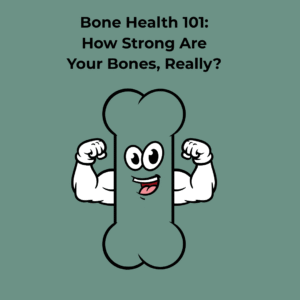Bone Health 101: How Strong Are Your Bones, Really?
Bone Health 101: How Strong Are Your Bones, Really?
You probably don’t think much about your bone health—until something goes wrong. But did you know that your bones are living tissue, constantly renewing themselves? Or that your bone mass peaks by your early 30s and slowly declines after that?
If you’ve ever had a fracture, been told you're "at risk of osteoporosis," or just want to age well, then bone health is a topic worth getting serious about.
In this 10-part series, we’ll unpack what you need to know about your skeleton: from how bone is built, to how it breaks down, and what you can do every day to keep it strong.
🧬 What Are Bones Made Of?
Bones are not just dry sticks under your skin—they’re dynamic, living tissue made of:
- Collagen – a flexible protein that gives bones a bit of bend.
- Calcium phosphate – a mineral that gives bones their strength and hardness.
- Bone cells – like osteoblasts (build bone), osteoclasts (break bone down), and osteocytes (manage the process).
Your bones are constantly remodeling—breaking down and rebuilding—based on the stress and loads placed on them. That’s why movement, nutrition, and hormones play such a key role in maintaining bone strength.
📈 Bone Through the Lifespan
- Childhood & Adolescence: This is when bones grow rapidly. Active play, good nutrition, and strength-based movement help lay down bone density.
- 20s–30s: Peak bone mass is achieved around the late 20s. Think of it as your "bone savings account." Maximize this.
- 40s–60s: Bone loss begins. This is especially accelerated in women after menopause due to a drop in estrogen.
- 60+: Bones become more brittle and lose flex. Risk of fractures increases, especially in the hips, spine, and wrists.
That means the actions you take today—no matter your age—can affect how mobile and strong you’ll be decades from now.
🦴 Why Bone Health Matters More Than You Think
Most people associate bone issues with osteoporosis or fractures—but the impacts of poor bone health ripple far wider:
- Falls and fractures are the leading cause of injury-related hospitalisation in Australians over 65.
- Poor posture and spine issues can be signs of weakened vertebrae or spinal degeneration.
- Back pain can be tied to changes in bone density, structure, or stress responses.
- Mobility and independence in later life depend heavily on maintaining skeletal strength.
Chiropractic care focuses not only on spinal alignment but also on the health and resilience of the supporting structures—including your bones.
✅ Three Simple Actions to Support Your Bones Today
- Get Moving Daily
Bones respond to load. Walking, climbing stairs, resistance training, and even dancing all stimulate bone-building cells. Bone responds to increased load by increasing bone formation. When bone loads go beyond habitual loads they improve, at any age! - Boost Your Bone Nutrients
Make sure you’re getting enough calcium, magnesium, vitamin D, and protein. These are the key ingredients for bone repair and strength. - Check in with Your Spine
A chiropractic assessment can help identify postural changes, joint stiffness, or vertebral degeneration—often early signs of bone stress.
💬 Let’s Keep It Simple
You don’t have to overhaul your life to improve your bone health. Just a few Simple Daily actions—moving more, eating well, and getting support when you need it—can help your skeleton stay strong for the long run.
In our next email, we’ll look at how bones change across the lifespan and why childhood and teenage years are critical for long-term bone strength.
Until then, keep moving smart and stay strong.
